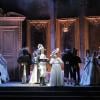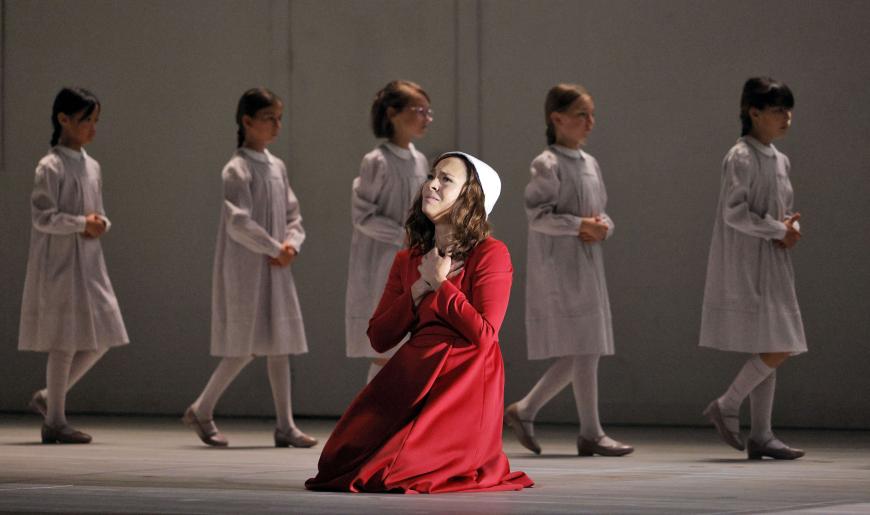
When you take a deeply disturbing novel about a brutally misogynistic society where the few fertile women left are stripped of their rights, held captive, constantly spied on, and ritually raped in hopes that they might bear children, then set it to music of fiercely raw potency, you get an opera of almost unbearable intensity.
That’s composer Poul Ruders and librettist Paul Bentley’s harrowing and brilliant adaptation of Margaret Atwood’s dystopian novel The Handmaid’s Tale, which finally arrived at the War Memorial Opera House on Saturday, Sept. 14, four years after the pandemic upended San Francisco Opera’s original plans to present the work.
Commissioned by the Royal Danish Theatre and first performed there in 2000, the opera hews closely to Atwood’s 1985 novel, about a Handmaid named Offred who recounts her life both before and after revolutionaries overthrow the United States to create the rigidly patriarchal Republic of Gilead.
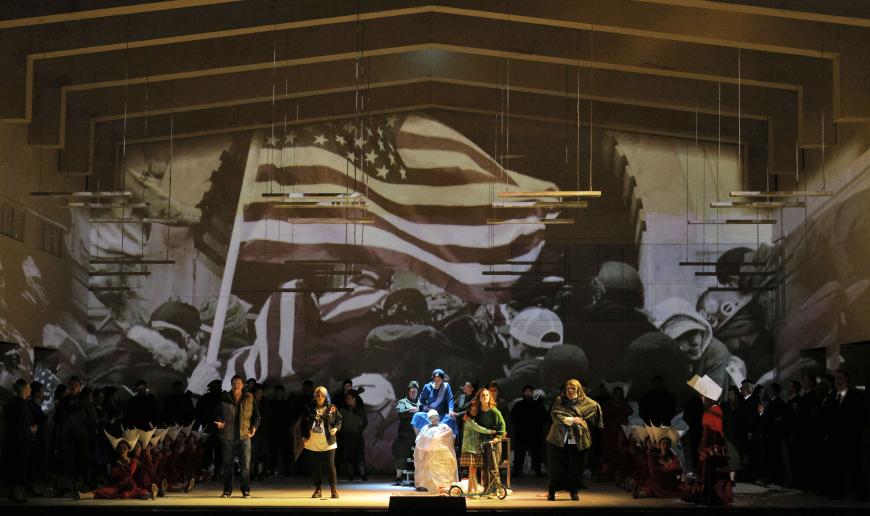
Bentley’s taut libretto breaks the novel down into more than 30 fast-moving scenes. Gilead and the Time Before are depicted simultaneously, with Offred portrayed onstage by two singers. One wears the Handmaid’s uniform of a red habit and white wimple, while the other wears contemporary street clothes and interacts freely with her husband, mother, and young daughter.
American mezzo-soprano Irene Roberts is the big star of this show, giving a courageous, vulnerable, and gorgeously sung performance as the Handmaid Offred. She was captured when she tried to escape Gilead with her family and handed over to the Aunts, the teachers and enforcers of the new society’s norms, who are clad in military-style uniforms.
Roberts’s counterpart is the wonderful mezzo-soprano Simone McIntosh, who as the younger Offred moves with the freedom of a 21st-century American woman. The two singers look and sound enough alike to be wholly convincing as the same person. Deep in the second act, they sing a duet of guilt, anger, reminiscence, and longing, wondering where their daughter is, whether she’s alive, what could have been different.
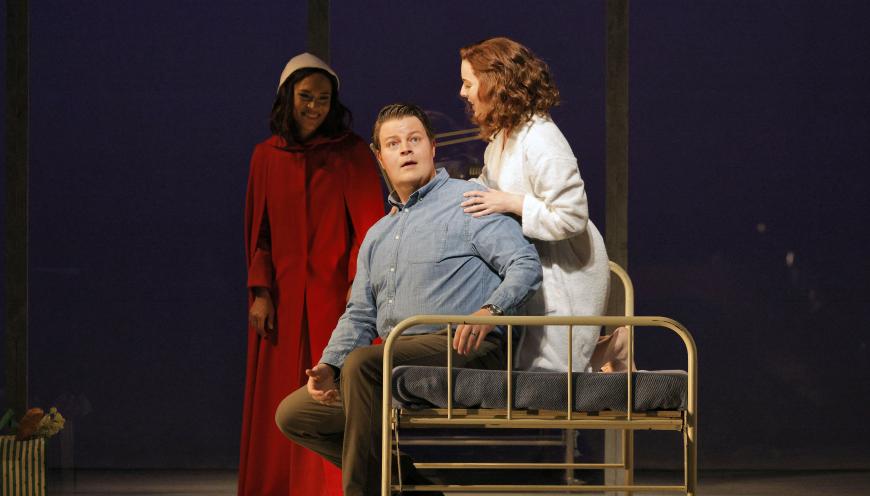
In the Time Before, tenor Christopher Oglesby portrays Offred’s husband, Luke, with appealing goofiness, while mezzo-soprano Gabrielle Beteag pulls you right into the world of Offred’s radical feminist mother, who correctly foresees what will become Gilead. Soprano Caroline Corrales is a jaunty Moira, Offred’s lesbian friend who manages to escape enslavement as a Handmaid.
In Gilead, Offred serves a Commander (the imposing, gritty-voiced bass John Relyea) and his Wife, Serena Joy (mezzo-soprano Lindsay Ammann), who hope their Handmaid will bear them a healthy child. Ammann, in particular, sings with cold disdain and a luscious, darkly beautiful voice. Bear in mind the horror here: The staging’s explicit, ritualized depictions of rape, executions, and other violence will make you want to flee.
For the role of the terrifying and vicious head Aunt, Lydia, Ruders has composed punishingly high and jagged music, and soprano Sarah Cambidge delivers it with bravura confidence and brilliant tone.
The cloistered Handmaids sing in chant and speak to each other in formulaic phrases, their very words controlled by their station. Soprano Rhoslyn Jones brings a majestic, full-toned dignity to the role of Offred’s walking companion, Ofglen, who eventually kills herself to avoid betraying the resistance.
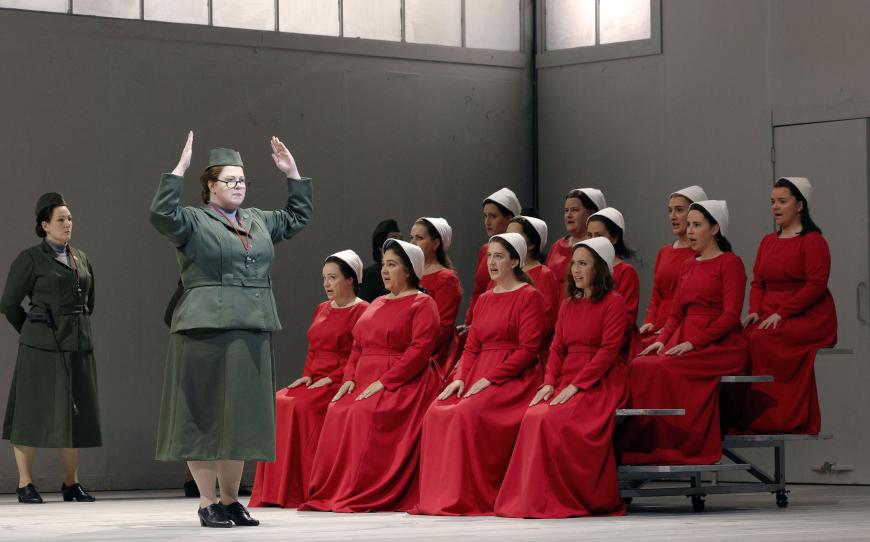
The Handmaid’s Tale is a modern horror story, and Ruders’s largely dissonant score — drifting harmonies, skittering strings and winds, relentless timpani — sets an ominous, doom-laden tone from the first measures.
The mood of the music does change with the setting. There’s lyricism in Offred’s arias and some tenderness when she makes love with the chauffeur Nick (the excellent tenor Brenton Ryan), whom Serena Joy has nominated to impregnate Offred after the Commander apparently can’t.
A scene in a brothel commences with jazzy accompaniment. Children crossing the stage are accompanied by a nursery tune. Most strikingly, Ruders weaves the hymn “Amazing Grace” throughout the score, a reminder that the song’s author worked in the slave trade before reforming and becoming an abolitionist.
All of this plays out within an austere unit set designed by Chloe Lamford, which provides director John Fulljames with plenty of working room while also reflecting the claustrophobia and confinement of Gilead. Walls fly up and down to partition the space; members of the stage crew roll furniture on and off as needed. Fulljames directs the large cast with sensitivity and cinematic sweep, and conductor Karen Kamensek brings clarity and drama to the dense and complex score.
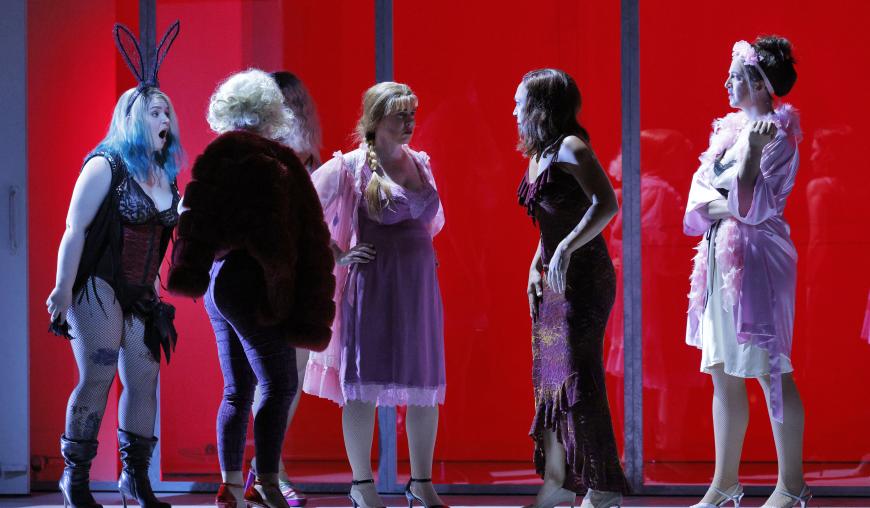
Atwood has always said that her novel isn’t fantasy because every event in it has happened somewhere on Earth. Since Ruders composed The Handmaid’s Tale 25 years ago, everything has changed and nothing has changed. In Afghanistan, women have lost the right to speak with men they’re not related to. In the U.S., the Supreme Court has taken away the constitutional right to abortion.
At the end of Atwood’s story, Offred is spirited away by what she hopes is the resistance, but we ultimately don’t know her fate. In the opera’s closing scene, the cast and chorus come forward to the lip of the stage, a few of them holding up cardboard signs that spell out “IN HOPE.” We can but hope, and resist the forces that lead us toward a darker world.
SF Opera’s production of Poul Ruders’s The Handmaid’s Tale runs through Oct. 1, with the Sept. 20 performance available for livestream viewing.
This story was first published in Datebook in partnership with the San Francisco Chronicle.




